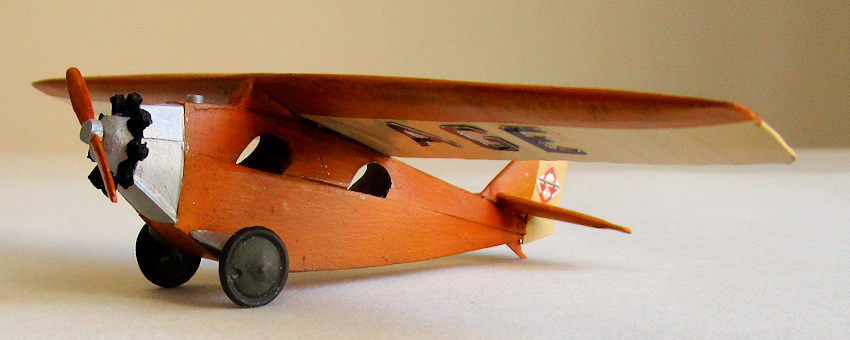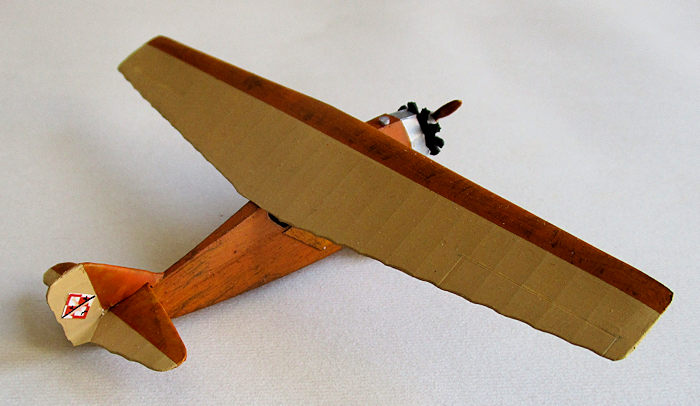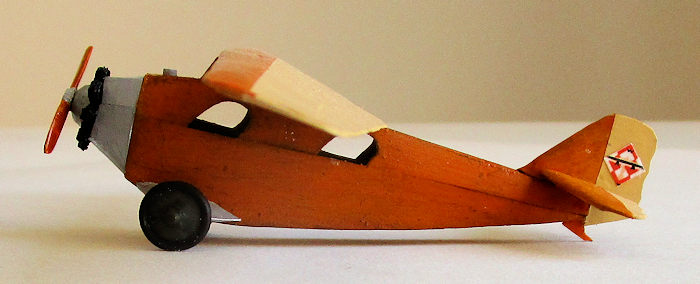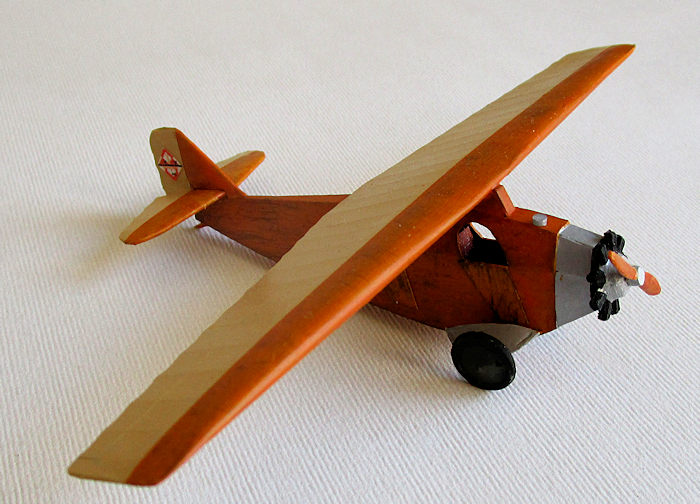
1/72 RWD-2
| KIT #: | |
| PRICE: | |
| DECALS: | Home Made |
| REVIEWER: | Chris Peachment |
| NOTES: | Made from 10 and 20 thou plastic card, rod and strut. Aided by a 40 year old spares box. |

| HISTORY |
The RWD-2 was a Polish built light sports aircraft, designed by the well known Polish three man team, Stanislaw Rogalski, Stanislaw Wigura and Jerzy Drzewiecki, whose names I can spell for you though not pronounce.
The first prototype, registration SP-AGE which I chose to model, was completed and flown in July 1929. It was successful and so three more were built in 1930.
 In August 1929, the prototype was flown across Europe, on the 5,000
km Warsaw-Paris-Barcelona- Warsaw route which was the first long foreign
flight of a Polish-designed aircraft. On 16 October 1929, it set an
international FAI altitude record of 13,133ft in the light tourist plane
class.
In August 1929, the prototype was flown across Europe, on the 5,000
km Warsaw-Paris-Barcelona- Warsaw route which was the first long foreign
flight of a Polish-designed aircraft. On 16 October 1929, it set an
international FAI altitude record of 13,133ft in the light tourist plane
class.
Three aircraft took part in the Challenge 1930 international touring planes competition in July, taking 19th and 21st places, thus securing Best Polish placing, and winning the trial for lowest fuel consumption, using 5.2kg per 100 km. According to Flight Magazine, they "possess particularly good air-sailing qualities".
The framework and some of the flying surfaces were wood, with the rear part of the wing and tailplanes covered in linen. The engine was a Salmson 9, 46hp 9-cylinder radial. And the fixed landing gear had bungee cord suspension.
You can blame your Editor for this one, as he did a very nice little RWD-5 not long ago, and mentioned that earlier marks of RWD had a “fish-like” fuselage with no forward view. This look was not unique in the 1920s, and if you check on the Messerschmitt M-17 of this period, you will see remarkable similarities, apart from the fact that the M-17 had a much longer, glider-like wingspan. The “fish-like” fuselage is also very close in appearance to the French Albessard Triavion, although this had two tandem wings.
 Why designers of this period opted to have no forward view for the
pilot is a mystery. Perhaps they thought that flying was becoming too
easy since WWI and it was about time to start giving pilots a few
obstacles to sort the sheep from the goats. All I can say is that I
wouldn't want to climb into a machine which you had to land without
seeing where you were going. Although with no windows in the side
apertures, you could at least hang your head over the edge. Bad luck if
there was a tree coming up on your other side.
Why designers of this period opted to have no forward view for the
pilot is a mystery. Perhaps they thought that flying was becoming too
easy since WWI and it was about time to start giving pilots a few
obstacles to sort the sheep from the goats. All I can say is that I
wouldn't want to climb into a machine which you had to land without
seeing where you were going. Although with no windows in the side
apertures, you could at least hang your head over the edge. Bad luck if
there was a tree coming up on your other side.
Someone with an apt turn of phrase gave them the nickname “blind mice”.
| CONSTRUCTION |
 Construction couldn't be simpler and it might well suit the
first-time scratch-builder. Plans were found on one of the websites
below, adjusted to scale, and printed off. After that it was simply a
task of cutting out each paper panel, tacking it to some 20 thou plastic
card, cutting the various panels out and then glueing them all together.
It just follows the usual path of an injected kit, and it couldn't be
simpler. As the side windows are open, you can see inside the cockpit,
and so a couple of little instrument panels, sticks and seats from the
spares box were included, together with some bulkheads. Maps in Polish
were beyond my linguistic means.
Construction couldn't be simpler and it might well suit the
first-time scratch-builder. Plans were found on one of the websites
below, adjusted to scale, and printed off. After that it was simply a
task of cutting out each paper panel, tacking it to some 20 thou plastic
card, cutting the various panels out and then glueing them all together.
It just follows the usual path of an injected kit, and it couldn't be
simpler. As the side windows are open, you can see inside the cockpit,
and so a couple of little instrument panels, sticks and seats from the
spares box were included, together with some bulkheads. Maps in Polish
were beyond my linguistic means.
| COLORS & MARKINGS |
The forward nose is a little tricky to get right, with its multiple angles. It is aluminium, while the rest of the wooden fuselage is done in Mid Stone from the Lifecolor range, with some Dark Earth dry brushing for the grain and a final coat of Vallejo Clear Orange, which I like because it is thin and matt, unlike the Tamiya variety, which is too glossy for this aircraft and has a tendency to clump, unless applied quickly.
| MORE CONSTRUCTION |
 The wing was made in one piece of 10 thou card, folded over a main
spar set one third back from the leading edge. The trailing edge
scallops were cut with a sharp scalpel, following the plan closely. The
linen parts of the wing were Vallejo Buff which I usually use for Clear
Doped line. The wood parts were done in the same way as the fuselage.
The wing was made in one piece of 10 thou card, folded over a main
spar set one third back from the leading edge. The trailing edge
scallops were cut with a sharp scalpel, following the plan closely. The
linen parts of the wing were Vallejo Buff which I usually use for Clear
Doped line. The wood parts were done in the same way as the fuselage.
You are going to need a couple of carefully sculpted wedges, one fore and one aft, to hold the wing to the fuselage. It is easier to look at the photos than try to describe them. They were carved from solid, with much checking against the curve of the wing lower surface as the sanding went along.
 A tiny fuel filler cap, end-cut from plastic rod, makes an nice
detail, as do a couple of doors cut from 10 thou card and glued on the
outside, complete with wood grain going in a different direction from
the fuselage.
A tiny fuel filler cap, end-cut from plastic rod, makes an nice
detail, as do a couple of doors cut from 10 thou card and glued on the
outside, complete with wood grain going in a different direction from
the fuselage.
The undercarriage struts are nicely faired one piece units, which I sanded from solid. Wheels came from the spares box. As did the Salmson engine, though it needed a nose fairing which proved tricky to cut out. Markings were run up on home made decal sheet, with a colouful little emblem on the tail done by hand with red, white and black felt tip. There might be lettering on the original, but in this scale it is unreadable. Remember to varnish it, or the ink will run all over the place. Finally a tiny propeller was cut down from an already small propeller, painted wood and stuck on at ten to four.
| CONCLUSIONS |
Any aviation at all from the 20s and 30s, let alone civilian and sports aircraft, are few and far between from the mainstream manufacturers. I don't know why this is, because it was a Golden Era for aviation, and the sheer number of different types was dizzying. So if you want something like this charming little item, then scratch building is the answer. And it isn't that difficult, especially with this particular aircraft. Only one wing, a simple colour scheme, few markings and above all, for the nervous among you, no rigging. If you have never tried it before, then dip your toe in the waters with this blind mice, and you will be well and easily rewarded with something unique.
| REFERENCES |
http://www.airwar.ru/enc/law1/rwd2.html
http://www.aviastar.org/air/poland/rwd-2.php
http://pwm.org.pl/viewtopic.php?f=13&t=5170&start=30
http://en.wikipedia.org
3 October 2016 Copyright ModelingMadness.com
If you would like your product reviewed fairly and fairly quickly, please contact the editor or see other details in the Note to Contributors.